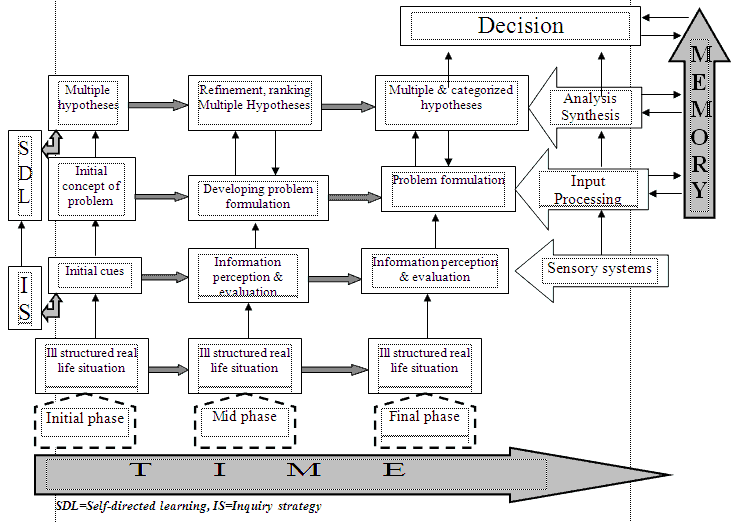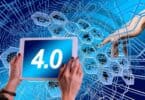The Essential Characteristics of Problem-Based Learning
From all the discussions so far we can improvise a very simplified definition of PBL as a process of learning based on problem or learning to learn. This definition despite its dearth of expandable words holds the key cue to the instigating approach to problem-based learning. But it would also make PBL very unsuccessful and incomplete if it were practiced with such skimpy conceptual definitions. It is true that in PBL the problem is encountered first in the learning process and serves as a focus or stimulus for the application of problem-solving or reasoning skills, as well as for the search or study of information or knowledge needed to understand the mechanisms responsible for the problem and how it might be resolved. Finding answer to a question is not problem-based learning (and this is where most people misinterpret PBL the most). The use of known principle or solution to explain an observation of phenomenon is not problem-based learning either.5 This functional concept of PBL should be clarified with some standard points of comparison. But before that some essential characteristics of PBL should be listed.
Problem-Based Learning has several distinct characteristics, which may be identified and utilized in designing a PBL curriculum: 1. Use of real world problems – problems are relevant and contextual. It is in the process of struggling with actual problems that students learn content and critical thinking skills.
2. Reliance on problems to drive the curriculum – the problems do not test skills; they assist in development of the skills themselves. 3. The problems are truly ill structured – there is not meant to be one solution, and as new information is gathered in a reiterative process, perception of the problem, and thus the solution, and all these bare the potential of cyclical changes. 4. PBL is learner-centered – learners are progressively given more responsibility for their education and become increasingly independent of the teacher for their education. 5. PBL produces independent, life-long learners – students continue to learn on their own in life and in their careers. Since students “learn to learn”, PBL basically instills within the students the process of independent learners.
These distinct characteristics of PBL are supposed to achieve some goals such as (modified excerpt to generalize the goals from Barrow’s6: How to Design a Problem-Based Curriculum for the Preclinical Years, 1985):
1. Acquisition of a knowledge base that is :
a) Organized in a more useful way for its application in subsequent work.
b) Recalled or retrieved in the subject context.
c) Easily extended through future self-directed study.
2. Development of scientific or analytic reasoning skills (problem-solving) in using the knowledge acquired. Skills that would lead to professional expertise in the subject setting.
3. Development of self-directed learning skills as a life-habit. This includes self-evaluation and self-monitoring as well as skills in using a variety of information resources.
4. Encouragement of independent and critical thinking. The context and environment of PBL stimulates critical thinking within the participant exposed to the proper process of PBL. The procedures in PBL further enhances independent learning.
5. Encouragement of integration of information from the various basic subjects and understanding of the basic mechanism of the problem. PBL curriculum is designed in such a way that activities within the process would direct students to view problem solving as a means of utilizing all possible knowledge sources. PBL ideally is a comprehensive learning process.
6. Providing the students with:
a) A motivating and exciting learning method.
b) The perception that their learning is relevant.
c) À method that allows for individualized learning
All of these objectives are addressed simultaneously in this approach. There are a variety of problem-based learning courses in existence (which are actually the product of misconceptions) around the world that is different from the method described there. This is because they do not address all these objectives in chorus. For example: 1. If effective self-assessment and self-directed learning skills as a life time habit were not an objective, the information to be learned to understand each problem could be described by the faculty and in the necessary learning resources, lectures, text assignments, and syllabi provided to the students during their work with the problem. This is contradiction to PBL philosophy (see 1st part of the article). 2. If the development of reasoning skills that lead to professional expertise was not an objective, the students could be asked to read trough a stock of printed problems or given a posed question or problem for them to determine what they need to know to solve such problem. The students would not be asked to go through the multiple hypothetico-deductive methods, asking questions and performing skills to obtain data to analyze the problem.
From my own experience while orientating PBL in 19 different medical colleges of Bangladesh through 19 workshops and group works on preparation of tutor guide, it was clear from the analysis of the tutor guides that faculty members think they have conceptualized PBL after a brief lecture on PBL, but the truth is most of them forget what is the core idea of reasoning, and what one is expected benefit from this reasoning skills (see the 2nd part of the article for reasoning skills’ example). PBL and reasoning skills is inseparable. Going through the steps of reasoning and being motivated to questioning/inquiring which eventually gives rise to the habit of self-directed learning is the secret to the life long memory gained by the practitioners of PBL. But when someone misses these points and attributes PBL to a learning method where the presence of problem is all that matters, PBL wouldn’t be beneficial, reasoning is the indissoluble nature of PBL. How this reasoning benefits a learner with or without his or her concern is shown diagrammatically below. It will be noticed that this is nothing but segmentation of the example of clinical reasoning that was given previously (used in McMaster University, Canada). Before showing the diagram the reader is advised to think over the following points which are the steps of reasoning process divided conveniently into some distinct behaviors that can be evaluated and learned:
1. Information perception and interpretation (problem identification)
2. Hypothesis generation
3. Inquiry strategy and skills
4. Problem formulation
5. Decision (problem solving)
These components would now be integrated to show the steps correlated in the process of PBL and also the benefit gained with regards to life-long memory: Fig: This figure is taken from the book titled- Problem-Based Learning: An Approach to Medical Education by Howard S. Barrows & Robyn M. Tamblyn. The figure has been modified by the author of this article in the following ways: i) 4 separate diagrams have been linked in series ii) separate phases are attributed to show the evolutionary progress of achievement in the process of reasoning skill iii) the entire diagram has been linked & integrated to show how memory is enhanced with the progress in achievement and performance of reasoning skills.
Reference
5. Sussan M, Luccero, Rebecca J et al. Tutorial groups in Problem-Based Learning. In: Kaufman A (ed). Implementing Problem-Based Medical Education. 1st ed., New York, Springer Publication Co, Inc., 1985
6. .Barrows HS. How to design problem-based curriculum for the preclinical years. New York (NY)Springer Publishing Company, Inc .1985.







Leave a Comment